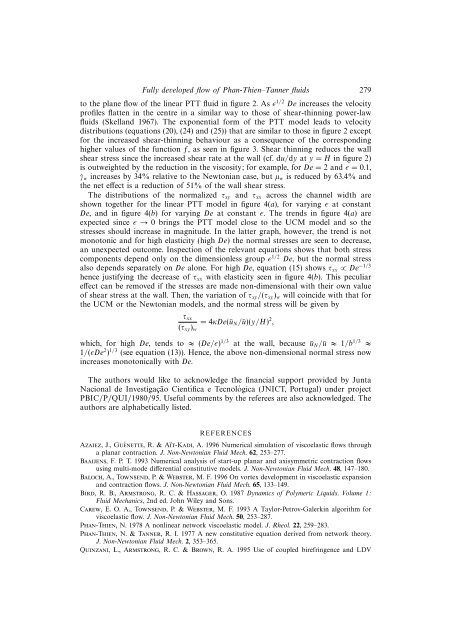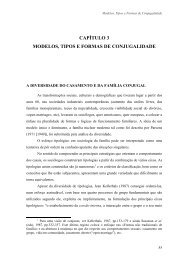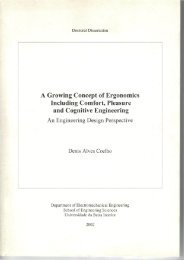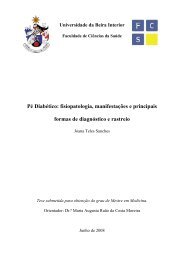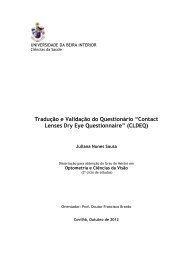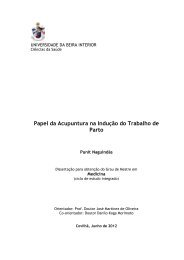Analytical solution for fully developed channel and pipe flow of Phan ...
Analytical solution for fully developed channel and pipe flow of Phan ...
Analytical solution for fully developed channel and pipe flow of Phan ...
- No tags were found...
Create successful ePaper yourself
Turn your PDF publications into a flip-book with our unique Google optimized e-Paper software.
Fully <strong>developed</strong> <strong>flow</strong> <strong>of</strong> <strong>Phan</strong>-Thien–Tanner fluids 279to the plane <strong>flow</strong> <strong>of</strong> the linear PTT fluid in figure 2. As ɛ 1/2 De increases the velocitypr<strong>of</strong>iles flatten in the centre in a similar way to those <strong>of</strong> shear-thinning power-lawfluids (Skell<strong>and</strong> 1967). The exponential <strong>for</strong>m <strong>of</strong> the PTT model leads to velocitydistributions (equations (20), (24) <strong>and</strong> (25)) that are similar to those in figure 2 except<strong>for</strong> the increased shear-thinning behaviour as a consequence <strong>of</strong> the correspondinghigher values <strong>of</strong> the function f, as seen in figure 3. Shear thinning reduces the wallshear stress since the increased shear rate at the wall (cf. du/dy at y = H in figure 2)is outweighted by the reduction in the viscosity; <strong>for</strong> example, <strong>for</strong> De = 2 <strong>and</strong> ɛ =0.1,˙γ w increases by 34% relative to the Newtonian case, but µ w is reduced by 63.4% <strong>and</strong>the net effect is a reduction <strong>of</strong> 51% <strong>of</strong> the wall shear stress.The distributions <strong>of</strong> the normalized τ xy <strong>and</strong> τ xx across the <strong>channel</strong> width areshown together <strong>for</strong> the linear PTT model in figure 4(a), <strong>for</strong> varying ɛ at constantDe, <strong>and</strong> in figure 4(b) <strong>for</strong> varying De at constant ɛ. The trends in figure 4(a) areexpected since ɛ → 0 brings the PTT model close to the UCM model <strong>and</strong> so thestresses should increase in magnitude. In the latter graph, however, the trend is notmonotonic <strong>and</strong> <strong>for</strong> high elasticity (high De) the normal stresses are seen to decrease,an unexpected outcome. Inspection <strong>of</strong> the relevant equations shows that both stresscomponents depend only on the dimensionless group ɛ 1/2 De, but the normal stressalso depends separately on De alone. For high De, equation (15) shows τ xx ∝ De −1/3hence justifying the decrease <strong>of</strong> τ xx with elasticity seen in figure 4(b). This peculiareffect can be removed if the stresses are made non-dimensional with their own value<strong>of</strong> shear stress at the wall. Then, the variation <strong>of</strong> τ xy /(τ xy ) w will coincide with that <strong>for</strong>the UCM or the Newtonian models, <strong>and</strong> the normal stress will be given byτ xx=4κDe(ū N /ū)(y/H) 2 ,(τ xy ) wwhich, <strong>for</strong> high De, tends to ≈ (De/ɛ) 1/3 at the wall, because ū N /ū ≈ 1/b 1/3 ≈1/(ɛDe 2 ) 1/3 (see equation (13)). Hence, the above non-dimensional normal stress nowincreases monotonically with De.The authors would like to acknowledge the financial support provided by JuntaNacional de Investigação Científica e Tecnológica (JNICT, Portugal) under projectPBIC/P/QUI/1980/95. Useful comments by the referees are also acknowledged. Theauthors are alphabetically listed.REFERENCESAzaiez, J., Guénette, R. & Aït-Kadi, A. 1996 Numerical simulation <strong>of</strong> viscoelastic <strong>flow</strong>s througha planar contraction. J. Non-Newtonian Fluid Mech. 62, 253–277.Baaijens,F.P.T.1993 Numerical analysis <strong>of</strong> start-up planar <strong>and</strong> axisymmetric contraction <strong>flow</strong>susing multi-mode differential constitutive models. J. Non-Newtonian Fluid Mech. 48, 147–180.Baloch, A., Townsend, P. & Webster, M. F. 1996 On vortex development in viscoelastic expansion<strong>and</strong> contraction <strong>flow</strong>s. J. Non-Newtonian Fluid Mech. 65, 133–149.Bird, R. B., Armstrong, R. C. & Hassager, O. 1987 Dynamics <strong>of</strong> Polymeric Liquids. Volume 1:Fluid Mechanics, 2nd ed. John Wiley <strong>and</strong> Sons.Carew, E. O. A., Townsend, P. & Webster, M. F. 1993 A Taylor-Petrov-Galerkin algorithm <strong>for</strong>viscoelastic <strong>flow</strong>. J. Non-Newtonian Fluid Mech. 50, 253–287.<strong>Phan</strong>-Thien, N. 1978 A nonlinear network viscoelastic model. J. Rheol. 22, 259–283.<strong>Phan</strong>-Thien, N. & Tanner, R. I. 1977 A new constitutive equation derived from network theory.J. Non-Newtonian Fluid Mech. 2, 353–365.Quinzani, L., Armstrong, R. C. & Brown, R. A. 1995 Use <strong>of</strong> coupled birefringence <strong>and</strong> LDV


